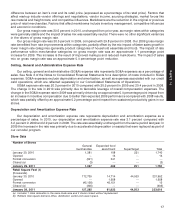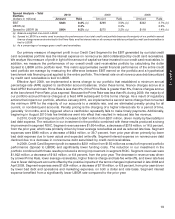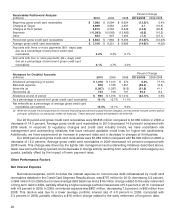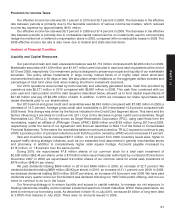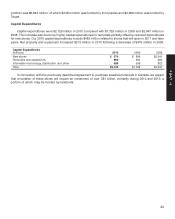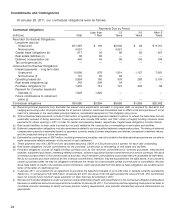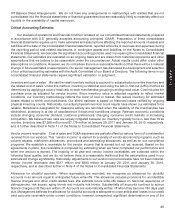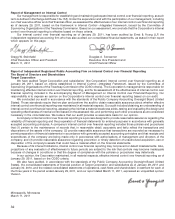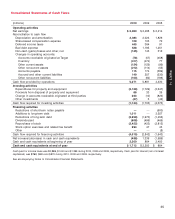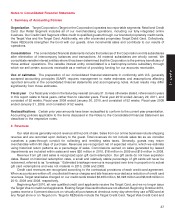Target 2010 Annual Report Download - page 49
Download and view the complete annual report
Please find page 49 of the 2010 Target annual report below. You can navigate through the pages in the report by either clicking on the pages listed below, or by using the keyword search tool below to find specific information within the annual report.
Pension and postretirement health care accounting We fund and maintain a qualified defined benefit pension
plan. We also maintain several smaller nonqualified plans and a postretirement health care plan for certain current
and retired team members. The costs for these plans are determined based on actuarial calculations using the
assumptions described in the following paragraphs. Eligibility for, and the level of, these benefits varies depending
on team members’ full-time or part-time status, date of hire and/or length of service.
Our expected long-term rate of return on plan assets is determined by the portfolio composition, historical
long-term investment performance and current market conditions. Benefits expense recorded during the year is
partially dependent upon the long-term rate of return used. A one percentage point decrease in the expected
long-term rate of return used to determine net pension and postretirement health care benefits expense would
increase annual expense by approximately $24 million.
The discount rate used to determine benefit obligations is adjusted annually based on the interest rate for
long-term high-quality corporate bonds as of the measurement date, using yields for maturities that are in line with
the duration of our pension liabilities. Therefore, these liabilities fluctuate with changes in interest rates. Historically,
this same discount rate has also been used to determine net pension and postretirement health care benefits
expense for the following plan year. Benefits expense recorded during the year is partially dependent upon the
discount rates used, and a 0.5 percentage point decrease to the weighted average discount rate used to determine
net pension and postretirement health care benefits expense would increase annual expense by approximately
$23 million.
Based on our experience, we use a graduated compensation growth schedule that assumes higher
compensation growth for younger, shorter-service pension-eligible team members than it does for older, longer-
service pension-eligible team members.
Pension and postretirement health care benefits are further described in Note 27 of the Notes to Consolidated
Financial Statements.
Legal contingencies We are exposed to claims and litigation arising in the ordinary course of business and use
various methods to resolve these matters in a manner that we believe serves the best interest of our shareholders
and other constituents. Historically, adjustments to our estimates have not been material. We believe the recorded
reserves in our consolidated financial statements are adequate in light of the probable and estimable liabilities. We
do not believe that any of the currently identified claims or litigation matters will have a material adverse impact on
our results of operations, cash flows or financial condition. However, litigation is subject to inherent uncertainties,
and unfavorable rulings could occur. If an unfavorable ruling were to occur, there may be a material adverse impact
on the results of operations, cash flows or financial condition for the period in which the ruling occurs, or future
periods.
New Accounting Pronouncements
Recent Adoptions
In June 2009, the FASB issued SFAS No. 166, ‘‘Accounting for Transfers of Financial Assets an amendment of
FASB Statement No. 140’’ (SFAS 166), codified in the Transfers and Servicing accounting principles, which amends
the derecognition guidance in former FASB Statement No. 140 and eliminates the exemption from consolidation for
qualifying special-purpose entities. We adopted this guidance at the beginning of 2010 and adoption had no impact
on our consolidated net earnings, cash flows or financial position.
In June 2009, the FASB issued SFAS No. 167, ‘‘Amendments to FASB Interpretation No. 46(R)’’ (SFAS 167),
codified in the Consolidation accounting principles, which amends the consolidation guidance applicable to
variable interest entities. The amendments significantly affected the overall consolidation analysis under former
FASB Interpretation No. 46(R). We adopted this guidance at the beginning of 2010 and the adoption had no impact
on our consolidated net earnings, cash flows or financial position.
27
PART II


